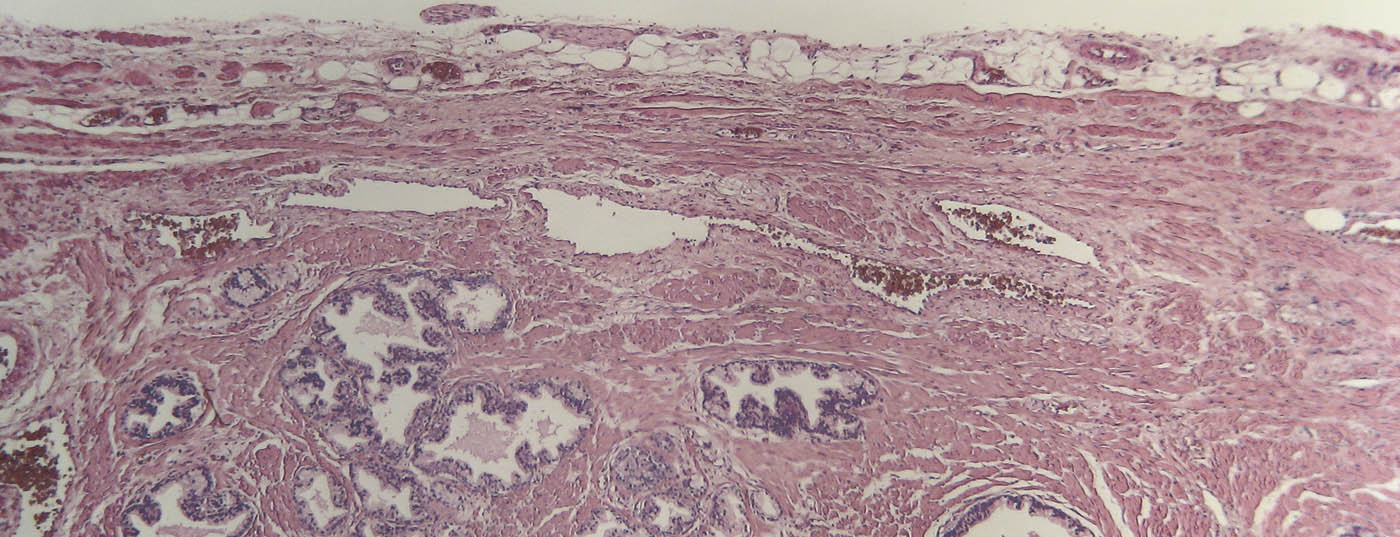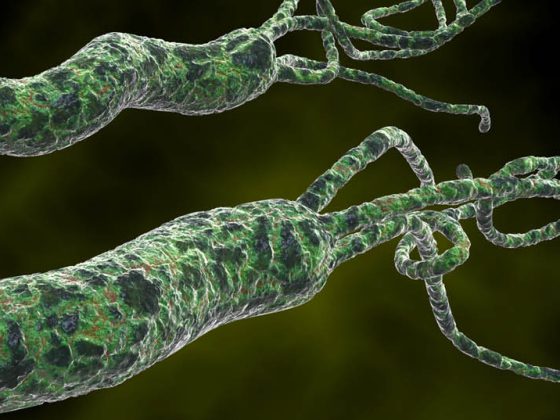The significant increase in available therapeutic agents in CRPC is encouraging. The focus of any therapy should be the preservation of quality of life with a reduction of tumor-specific complications. Due to the complexity combined with a lack of comparative data, the current EAU guidelines generally recommend a multidisciplinary approach in mCRPC patients and thus presentation to a tumor board.
Prostate cancer (PCa) is a heterogeneous tumor entity that subsumes both non-life-threatening tumors and those with highly aggressive and lethal courses. While the insignificant tumors are monitored by Active Surveillance, for localized forms an active approach such as radical surgery or radiotherapy is performed [1,2]. More therapeutically problematic are the aggressive (recurrent) tumors, which change dynamically from the time of diagnosis to tumor-related death in terms of clinic (localized vs. locally advanced), hormonal status (castration-sensitive vs. -refractory), and presence of metastases (M0 vs. M+) [3].
From hormonal PCa to CRPC
One to three years after initiation of anti-hormonal therapy (ADT), treatment resistance develops with tumor progression. The hormone axis remains central at this time [4], which is why a name change was made: “hormone-refractory” became “castration-refractory” PCa (CRPC) [1]. CRPC is present, according to the European Association of Urology, when testosterone levels are at castration levels, PSA levels rise three times at least one week apart, with two levels at least 50% above the nadir, and the peak >2 ng/ml – or if more than two new bone lesions occur and if a soft tissue lesion progresses [2].
CRPC is considered a highly aggressive and non-curable end-stage disease with a high risk of tumor-specific complications and tumor-related death. The therapeutic challenge lies in the complex molecular changes from castration-sensitive to -refractory tumor, including androgen receptor (AR)-dependent and AR-independent changes.
AR-dependent changes
Androgen hypersensitivity/AR amplification: increased mRNA transcription rates and improved mRNA and protein stabilization lead to increased amplification of the AR and thus a selection survival advantage [5,6].
Intracrine androgen synthesis: self-supply of androgen by increased conversion of testosterone to DHT (via increased 5-α-reductase concentration). CRPC cell lines are able to synthesize androgens from e.g. cholesterol by increased expression of all synthesis genes [7,8].
Ligand-independent AR activation: mutations increase the ability to activate adrenal androgens, estrogen, cortisol, and even AR antagonists. Mutations of the binding site for co-regulators and AR-splicing variants (AR 3, 4 and 5) can even lead to activation of the AR without any ligand at all [9–11].
AR activation by growth factors, cytokines and receptor tyrosine kinases: Growth factors (IGF-1, EGF) or cytokines (IL6) activate the AR and other oncogenic pathways such as RAS, RAF or MAPK and thus tumor growth. Tyrosine kinases such as ERBB2 also activate the AR via MAPK and PI3K/AKT [12].
AR-independent changes
Overexpression and activation of anti-apoptotic proteins: BCL2, clusterin, Hsp27, and TP53INP1 block and bypass apoptosis stimuli arising from androgen deprivation [12–15].
Mutation/deactivation of tumor suppressor genes (PTEN, RB, p53): PTEN loss leads to activation of AR via PI3K/AKT pathway and via this also to AR-independent effects such as reduced apoptosis and cell growth. Mutations of RB1/p53 result in cell proliferation ab- and independent of AR [12,16,17].
MicroRNAs (miRNAs): Upregulation was described for the OncomiRs miR-221/222, which inversely correlates to the expression of the cell cycle inhibitor p27. Direct and indirect regulation of AR has been demonstrated for miR-21, -141, and -221/222, as evidenced by an effect on the cell cycle, apoptosis, and metastasis. Anti-OncomiR-34 expression is dependent on the tumor suppressor p53 and results in cell cycle arrest and apoptosis via downregulation of BCl2 and CyclinD1 [18–21].
New agents for the therapy of CRPC
The goal of any therapy at this palliative stage is to reduce tumor-related complications while maintaining quality of life and prolonging overall survival. Until a few years ago, chemotherapy with docetaxel was the main treatment available for this purpose. However, based on the above-mentioned resistance mechanisms, various new substances with different targets have been developed to date (Fig. 1).
New anti-androgenic substances
Enzalutamide: Enzalutamide (Xtandi®) is a selective oral AR antagonist that inhibits AR activation, nuclear translocation and interaction with androgen-dependent genes. In the AFFIRM trial, 1199 CRPC patients with progression after docetaxel were randomized to treatment with enzalutamide (160 mg) or placebo. Overall survival showed a benefit of 18.4 vs. 13.6 months (HR 0.63; p<0.0001), corresponding to a mortality risk reduction of 37% [22]. In the PREVAIL trial of 1717 mCRPC patients prior to docetaxel, an interim analysis followed 540 deaths and showed a 29% reduction in mortality for enzalutamide (HR 0.71; p<0.0001) – as well as an 81% reduction in the risk of radiographic progression or death, both vs placebo. Side effects were mainly fatigue, diarrhea, and flushing [23].
Abiraterone: Abiraterone (Zytiga®) is a CYP17 inhibitor that inhibits androgen biosynthesis in the adrenal glands and testes, but also in the tumor cells themselves. The effect was demonstrated in two phase III trials in which abiraterone was tested against placebo both after (COU-AA-301) [24] and before (COU-AA-302) [25] docetaxel therapy. After chemotherapy, abiraterone patients showed significantly prolonged survival by 4.6 months (HR 0.74). Significant improvement in PFS was demonstrated before chemotherapy. The study was stopped early because of the positive data. After a follow-up of more than four years, there was a 19 percent mortality risk reduction (34.7 vs. 30.3 months; HR 0.81; p=0.0033) for the abiraterone group [26].
Chemotherapeutics
Docetaxel: Docetaxel (Taxotere®) 75 mg/m2 every three weeks has been the standard treatment in mCRPC since the Tax327 trial. Docetaxel 50 mg/m2 every two weeks has fewer side effects without being inferior to the three-weekly regimen in terms of time to treatment failure [27,28].
Cabazitaxel: Cabazitaxel (Jevtana®) is a tubulin-binding taxane with low affinity for p-glycoprotein (drug efflux). In the TROPIC trial, 755 men with progression after docetaxel were studied. Cabazitaxel with prednisone (10 mg/d) showed a significant prolongation of overall survival by 2.4 months compared with mitoxantrone. The main side effects are myelon suppression and diarrhea [29].
Radiotherapeutics
Alpharadin, Radium223: Alpharadin, Radium223, is an alpha emitter with a shallow penetration depth (<100 μm) and a half-life of 11.4 days. It is stored in place of calcium and leads to DNA double-strand breaks in bone metastases. In the phase III ALSYMPCA trial, more than 900 patients with symptomatic osseous mCRPC who had already undergone docetaxel therapy or were ineligible for it received either six i.v. injections of Ra223 at four-week intervals or placebo. This resulted in an overall survival benefit for Ra223 of 30%, (HR 0.699; p=0.0022) and a prolonged time to first SRE of 34% (HR 0.66; p<0.001 [30]).
Immunotherapy
Sipuleucel-T: Leukopheresis is used to isolate blood mononuclear cells, which are then incubated and reinfused with a recombinant protein containing prostate-specific acid phosphatase and GM-CSF. In the pivotal IMPACT trial, sipuleucel-T showed a 22.5% reduction in mortality risk (HR 0.78; p=0.03) and a significant 4.1-month increase in survival [31]. Although approved in the U.S., it should be noted in this study that in the control group, the blood mononuclear cells were not reinfused and this may have resulted in a weakening of the immune system.
Osseous therapy
In cases of osseous metastasis, therapy with denosumab or bisphosphonate should be given for prevention. If necessary, further therapies ranging from analgesics to interventions such as palliative radiotherapy or surgery should be initiated to avoid a reduction in quality of life [1].
Therapy sequence
The aggressiveness of treatment must be adapted to the patient’s individual overall situation – with the aim of improving quality of life, among other things. The best sequence of the new therapeutic modalities is unclear.
First-line therapy of CRPC
The optimal time to start therapy is unclear. Treatment is indicated for symptomatic mCRPC, rapid doubling of PSA levels (<2 months), and the presence of (new) visceral metastases [32].
Hormone-sensitive metastatic PCa: In the light of recent events, the CHAARTED trial (Chemo HormonalTherapy Versus Androgen Ablation Randomized Trialfor Extensive Diseasein Prostate Cancer) should be briefly mentioned. Currently, ADT represents the standard of care in metastatic but hormone-sensitive prostate cancer. This standard was compared with the combination of ADT plus a maximum of six cycles of chemotherapy with docetaxel (75 mg/m2, three times weekly) in the CHAARTED trial. The results show a statistically significant survival benefit of 17 months for PFS and OS in favor of combined chemo-hormone therapy [33,34].
Asymptomatic CRPC without metastases (M0) with rising PSA: This is a rare tumor stage (approx. 5%), in which the question is rather whether any metastases present have merely not been detected with current imaging so far. Accordingly, re-staging should be performed, and the optimal start of therapy is unclear. If possible, these patients should be included in currently active trials.
Asymptomatic or minimally symptomatic mCRPC without visceral metastases: Abiraterone as well as enzalutamide (in addition to ADT) may be considered. There are no direct comparative data and recommendations for either substance. Patients with a poor response to ADT (less than twelve months) have been observed to have a poorer response to further antihormonal therapies and therefore first-line docetaxel rather than abiraterone is recommended [35,36].
Symptomatic mCRPC without and with visceral metastases: Docetaxel therapy should be started in symptomatic patients without visceral metastases. If the metastasis is predominantly osseous, therapy with Alpharadin may be sought. If visceral metastases are present, chemotherapy with docetaxel is recommended [36].
Therapy sequence/second-line therapy of CRPC.
There are no clear data for the optimal sequence of the various substances, but there are orienting findings to consider.
There is no study directly comparing abiraterone before and after docetaxel therapy. Data can only be interpolated from COU-AA-301 and COU-AA-302 and suggest better efficacy in terms of PSA level drop for abiraterone before chemotherapy. Conversely, there are indirect data that prior abiraterone therapy negatively impacts subsequent docetaxel therapy in terms of PSA level decline, but also OS. The survival benefit observed in COU-AA-302 occurred primarily in patients with little pain and PSA ≤114 ng/mL, suggesting early initiation. Merseburger et al. conclude that patients without these variables should be more likely to start early chemotherapy [37]. For patients with rapid progression during or shortly after (less than three months) docetaxel therapy, Cathomas et al. more likely to start second-line chemotherapy with cabazitaxel [32]. Complicating matters is evidence of cross-resistance in the use of abiraterone and enzalutamide, implying clinically poorer response of each secondary administration, and evidence of cross-resistance between these agents and the taxanes [38].
Biomarkers, therapy monitoring and switching.
Currently, no biomarkers exist that predict whether mCRPC patients will respond better to chemotherapy with taxanes or hormone therapy. The extent to which current approaches such as circulating tumor cells might be helpful remains to be seen with interest. Recent data show that, for example, variant 7 AR in CTC is associated with resistance to abiraterone and enzalutamide [39]. Therapy monitoring by means of PSA value control is difficult due to described PSA fluctuations under modern medications or even a non-response with alpharadin or immunotherapy. In principle, a change in therapy should not be made on the basis of a rising PSA value alone, but only if, for example, radiological progression and/or AZ-worsening disease progression are added [35].
New substances
Experimentally, many new compounds that address the above AR-dependent and AR-independent changes are being tested. Their description is beyond the scope of this review, so reference is made to the abstract “Targeting the adaptive molecular landscape of castration-resistant prostate cancer” [40].
Literature:
- Heidenreich A, et al: EAU guidelines on prostate cancer. Part II: Treatment of advanced, relapsing, and castration-resistant prostate cancer. European Urology 2014; 65(2): 467-479.
- Heidenreich A, et al: EAU guidelines on prostate cancer. part 1: screening, diagnosis, and local treatment with curative intent-update 2013. European Urology 2014; 65(1): 124-137.
- Penning TM: Mechanisms of drug resistance that target the androgen axis in castration-resistant prostate cancer (CRPC). The Journal of steroid biochemistry and molecular biology 2015; 153; 105-113.
- Chen CD, et al: Molecular determinants of resistance to antiandrogen therapy. Nature medicine 2004; 10(1): 33-39.
- Edwards J, et al: Gene amplifications associated with the development of hormone-resistant prostate cancer. Clinical cancer research: an official journal of the American Association for Cancer Research 2003; 9(14): 5271-5281.
- Gregory CW, et al: Androgen Receptor Stabilization in Recurrent Prostate Cancer Is Associated with Hypersensitivity to Low Androgen. Cancer Research 2001; 61(7): 2892-2898.
- Montgomery RB, et al: Maintenance of intratumoral androgens in metastatic prostate cancer: a mechanism for castration-resistant tumor growth. Cancer Res 2008; 68(11): 4447-4454.
- Locke JA, et al: Androgen levels increase by intratumoral de novo steroidogenesis during progression of castration-resistant prostate cancer. Cancer Res 2008; 68(15): 6407-6415.
- Brooke GN, Bevan CL: The role of androgen receptor mutations in prostate cancer progression. Current Genomics 2009; 10(1): 18-25.
- Steinkamp MP, et al: Treatment-dependent androgen receptor mutations in prostate cancer exploit multiple mechanisms to evade therapy. Cancer Res 2009; 69(10): 4434-4442.
- Hornberg E, et al: Expression of androgen receptor splice variants in prostate cancer bone metastases is associated with castration-resistance and short survival. PloS one 2011; 6(4): e19059.
- Katsogiannou M, et al: The hallmarks of castration-resistant prostate cancers. Cancer Treatment Reviews 2015; 41(7): 588-597.
- McDonnell TJ, et al: Expression of the protooncogene bcl-2 in the prostate and its association with emergence of androgen-independent prostate cancer. Cancer Res 1992; 52(24): 6940-6944.
- July LV, et al: Clusterin expression is significantly enhanced in prostate cancer cells following androgen withdrawal therapy. The Prostate 2002; 50(3): 179-188.
- Rocchi P, et al: Increased Hsp27 after androgen ablation facilitates androgen-independent progression in prostate cancer via signal transducers and activators of transcription 3-mediated suppression of apoptosis. Cancer Res 2005; 65(23): 11083-11093.
- Sarker D, et al: Targeting the PI3K/AKT pathway for the treatment of prostate cancer. Clinical cancer research: an official journal of the American Association for Cancer Research 2009; 15(15): 4799-4805.
- Burchardt M, et al: Reduction of wild type p53 function confers a hormone resistant phenotype on LNCaP prostate cancer cells. The Prostate 2001; 48(4): 225-230.
- Galardi S, et al: miR-221 and miR-222 expression affects the proliferation potential of human prostate carcinoma cell lines by targeting p27Kip1. The Journal of biological chemistry 2007; 282(32): 23716-23724.
- Mercatelli N, et al: The inhibition of the highly expressed miR-221 and miR-222 impairs the growth of prostate carcinoma xenografts in mice. PloS one 2008; 3(12): e4029.
- Liu C, et al: The microRNA miR-34a inhibits prostate cancer stem cells and metastasis by directly repressing CD44. Nature medicine 2011; 17(2): 211-215.
- Spahn M, et al: Expression of microRNA-221 is progressively reduced in aggressive prostate cancer and metastasis and predicts clinical recurrence. International Journal of Cancer 2010; 127(2): 394-403.
- Sternberg CN, et al: Improved outcomes in elderly patients with metastatic castration-resistant prostate cancer treated with the androgen receptor inhibitor enzalutamide: results from the phase III AFFIRM trial. Annals of Oncology: official journal of the European Society for Medical Oncology/ESMO 2014; 25(2): 429-434.
- Beer TM, et al: Enzalutamide in metastatic prostate cancer before chemotherapy. The New England Journal of Medicine 2014; 371(5): 424-433.
- de Bono JS, et al: Abiraterone and increased survival in metastatic prostate cancer. The New England Journal of Medicine 2011; 364(21): 1995-2005.
- Ryan CJ, et al: Abiraterone in metastatic prostate cancer without prior chemotherapy. The New England Journal of Medicine 2013; 368(2): 138-148.
- Ryan CJ, et al: Abiraterone acetate plus prednisone versus placebo plus prednisone in chemotherapy-naive men with metastatic castration-resistant prostate cancer (COU-AA-302): final overall survival analysis of a randomised, double-blind, placebo-controlled phase 3 study. The Lancet Oncology 2015; 16(2): 152-160.
- Tannock IF, et al: Docetaxel plus prednisone or mitoxantrone plus prednisone for advanced prostate cancer. The New England Journal of Medicine 2004; 351(15): 1502-1512.
- Kellokumpu-Lehtinen PL, et al: 2-weekly versus 3-weekly docetaxel to treat castration-resistant advanced prostate cancer: a randomised, phase 3 trial. The Lancet Oncology 2013; 14(2): 117-124.
- de Bono JS, et al: Prednisone plus cabazitaxel or mitoxantrone for metastatic castration-resistant prostate cancer progressing after docetaxel treatment: a randomised open-label trial. Lancet 2010; 376(9747): 1147-1154.
- Parker C, et al: Alpha emitter radium-223 and survival in metastatic prostate cancer. The New England Journal of Medicine 2013; 369(3): 213-223.
- Kantoff PW, et al: Sipuleucel-T immunotherapy for castration-resistant prostate cancer. The New England Journal of Medicine 2010; 363(5): 411-422.
- Cathomas R, Steuber T, Gillessen S: Metastatic prostate carcinoma: fundamentals of therapy in 2013. Vienna Clin Mag 2013; 16(6): 20-25.
- Fizazi K, Jenkins C, Tannock IF: Should docetaxel be standard of care for patients with metastatic hormone-sensitive prostate cancer? Pros and cons. Annals of Oncology : official journal of the European Society for Medical Oncology/ESMO 2015; 26(8): 1660-1667.
- Sweeney CJ, Chamberlain D: Insights into E3805: the CHAARTED trial. Future Oncology 2015; 11(6): 897-899.
- Gillessen S, et al: Management of patients with advanced prostate cancer: recommendations of the St Gallen Advanced Prostate Cancer Consensus Conference (APCCC) 2015. Annals of Oncology: official journal of the European Society for Medical Oncology/ESMO 2015; 26(8): 1589-1604.
- Parker C, et al: Cancer of the prostate: ESMO Clinical Practice Guidelines for diagnosis, treatment and follow-up. Annals of Oncology: official journal of the European Society for Medical Oncology/ESMO 2015.
- Merseburger AS, et al: [Castration resistant prostate cancer 2015]. Current Urology 2015; 46(1): 59-65.
- van Soest RJ, et al: Cross-resistance between taxanes and new hormonal agents abiraterone and enzalutamide may affect drug sequence choices in metastatic castration-resistant prostate cancer. European Journal of Cancer 2013; 49(18): 3821-3830.
- Antonarakis ES, et al: AR-V7 and resistance to enzalutamide and abiraterone in prostate cancer. The New England Journal of Medicine 2014; 371(11): 1028-1038.
- Wyatt AW, Gleave ME: Targeting the adaptive molecular landscape of castration-resistant prostate cancer. EMBO molecular medicine 2015; 7(7): 878-894.
InFo ONCOLOGY & HEMATOLOGY 2015; 3(11-12): 14-19











